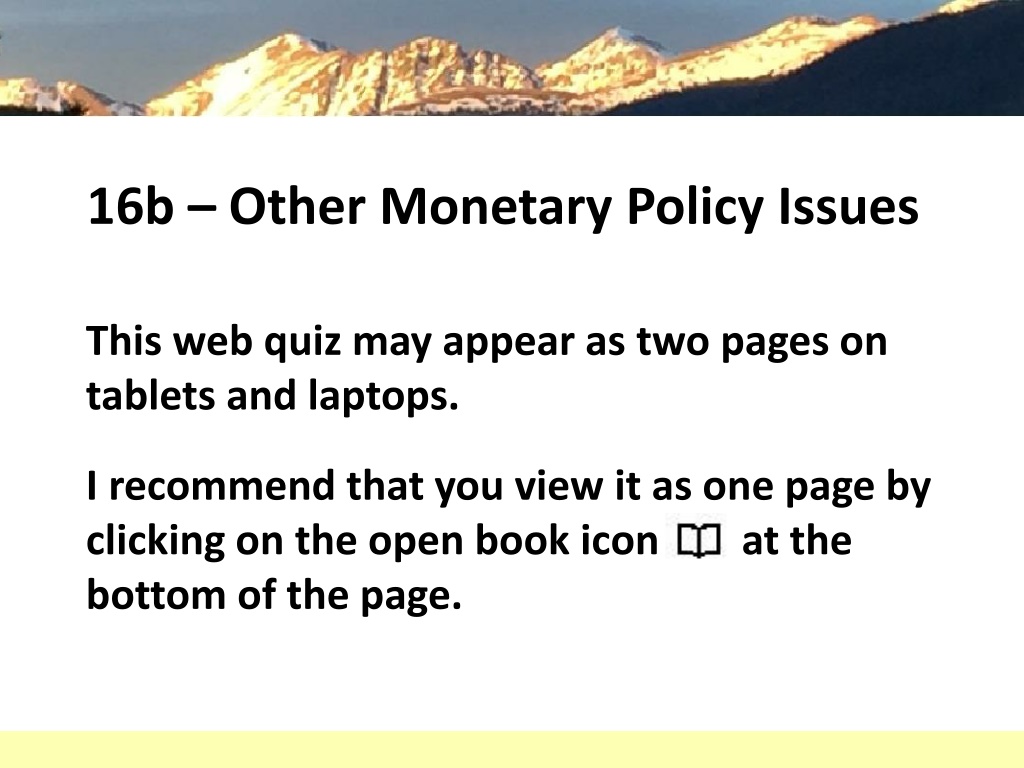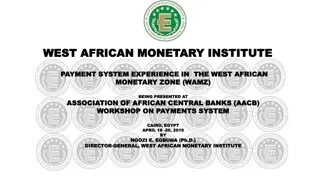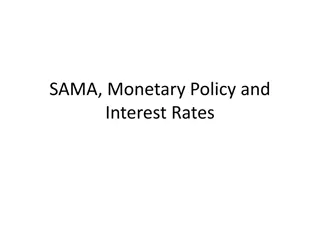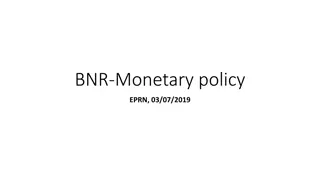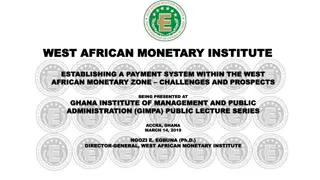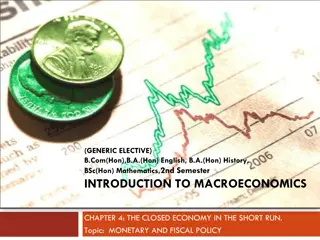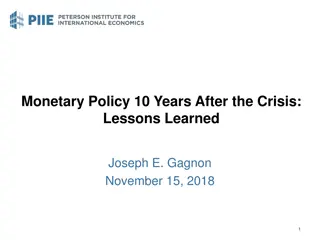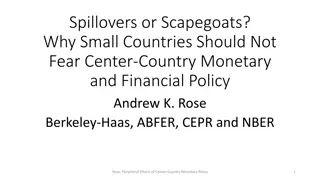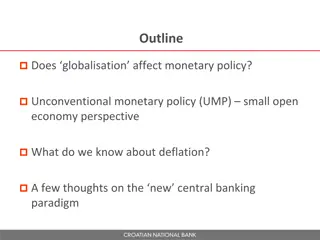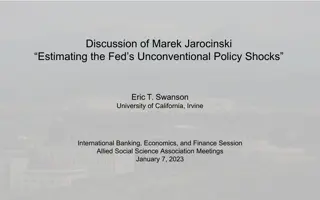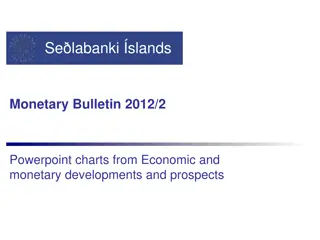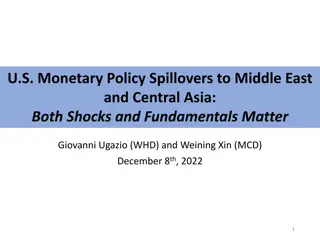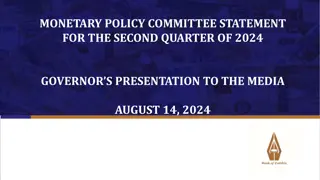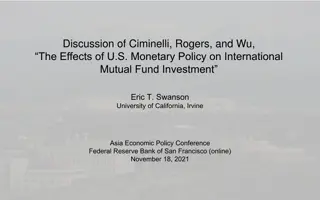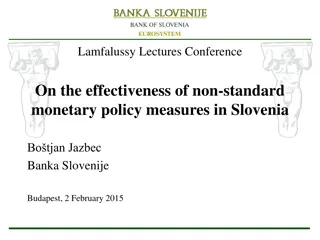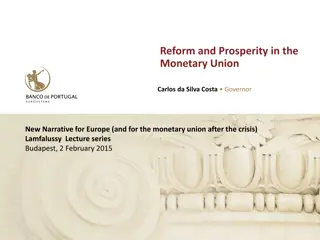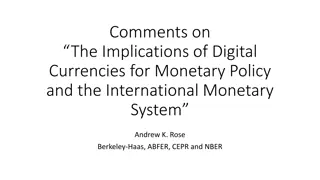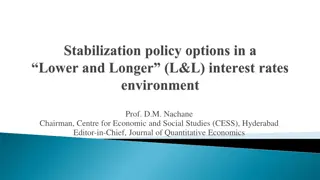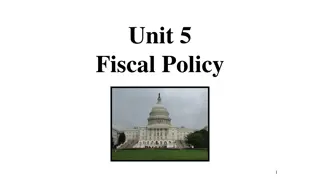Understanding Monetary Policy: Mainstream vs. Monetarist Perspectives
Learn about the strengths and shortcomings of monetary policy, compare mainstream (Keynesian) and monetarist (Classical) views on macroeconomic instability, discuss self-correction in the economy, and explore the debate between rules and discretion in conducting stabilization policy. Key terms include recognition lag, liquidity trap, efficiency wage, and more.
- Monetary Policy
- Mainstream Economists
- Monetarist Economists
- Macroeconomic Instability
- Stabilization Policy
Download Presentation

Please find below an Image/Link to download the presentation.
The content on the website is provided AS IS for your information and personal use only. It may not be sold, licensed, or shared on other websites without obtaining consent from the author. Download presentation by click this link. If you encounter any issues during the download, it is possible that the publisher has removed the file from their server.
E N D
Presentation Transcript
16b Other Monetary Policy Issues This web quiz may appear as two pages on tablets and laptops. I recommend that you view it as one page by clicking on the open book icon at the bottom of the page.
16b Other Monetary Policy Issues Strengths and Shortcomings of Monetary Policy. Compare Mainstream and Monetarist views: Causes of Macroeconomic instability Does the economy self-correct? Rules or Discretion? (Should the Fed do anything?) NOTE: We will keep things simple: Mainstream = New Keynesian Monetarist = New Classical
Monetary Policy (MP) Mainstream Economists (Keynesians) believe: MP is NOT effective, but it should be used Monetarist Economists (Classical) believe: MP is VERY effective and therefore it should NOT be used
16b Other Monetary Policy Issues Must Know / Outcomes: Know the strengths and shortcomings of monetary policy. Describe two alternative perspectives on the causes of macroeconomic instability: those held by mainstream (Keynesian) economists and the monetarists (Classical) Explain what the equation of exchange is and how it relates to "monetarism." Discuss why new classical economists (monetarists) believe the economy will "self-correct" from aggregate demand and aggregate supply shocks. Explain the view of self-correction held by mainstream economists. List three reasons why a higher wage could result in greater efficiency. Identify and describe the variations on the debate over "rules" versus "discretion" in conducting stabilization policy. Mainstream (New Keynesian) economists believe monetary policy is not very effective but it should be used to accommodate fiscal policy. Monetarists (New Classical) economists believe monetary policy is very effective but should not be used with discretion. EXPLAIN.
16b Other Monetary Policy Issues KEY TERMS: recognition lag, administrative lag, operational lag, cyclical asymetry, liquidity trap, equation of exchange, velocity of money, new classical economists (monetarists), mainstream economists (Keynesian), efficiency wage, monetary rule, inflation targeting,
16b Other Monetary Policy Issues Strengths and Shortcomings of monetary policy. Compare Mainstream and Monetarist views: Causes of Macroeconomic instability Does the economy self-correct? Rules or Discretion? (Should the Feddo anything?)
1. What are the tools of Monetary Policy (MP) and the tools of Fiscal Policy (FP)? 1. MP: G, T, MS; FP: DR, RR 2. MP: C, I, Xn; FP: G, OMO 3. MP: OMO, DR, RR; FP: G, T 4. MP: C, I, G, Xn FP: S, T, In MP: Strengths and Shortcomings
1. What are the tools of Monetary Policy (MP) and the tools of Fiscal Policy (FP)? 1. MP: G, T, MS; FP: DR, RR 2. MP: C, I, Xn; FP: G, OMO 3. MP: OMO, DR, RR; FP: G, T 4. MP: C, I, G, Xn FP: S, T, In MP: Strengths and Shortcomings
2. What are the two advantages of Monetary Policy (MP) over Fiscal Policy (FP)? 1. Speed/flexibility and free from political pressure 2. More democratic and less corruption 3. Can reduce IN without UE and shorter recognition lag 4. Supply side effects and no ratchet effect MP: Strengths and Shortcomings
2. What are the two advantages of Monetary Policy (MP) over Fiscal Policy (FP)? 1. Speed/flexibility and free from political pressure 2. More democratic and less corruption 3. Can reduce IN without UE and shorter recognition lag 4. Supply side effects and no ratchet effect MP: Strengths and Shortcomings
3. Compared to FP, MP has a SHORTER: 1. Recognition Lag 2. Administrative Lag 3. Operational Lag 4. Structural Lag MP: Strengths and Shortcomings
3. Compared to FP, MP has a SHORTER: 1. Recognition Lag 2. Administrative Lag 3. Operational Lag 4. Structural Lag MP: Strengths and Shortcomings
Time 1 to 2: Recognition Lag Time 2 to 3: Administrative Lag Time 3 to 4: Operational Lag Time 1: Economy enters a recession Time 2: Recession is recognized Time 3: Gov t enacts policy Time 4: Policy takes effect MP: Strengths and Shortcomings
Time Lags and Macroeconomic Policy Recognition Lag: Same for FP and MP Administrative Lag: Shorter for MP Operational Lag: Same for FP and MP MP: Strengths and Shortcomings
Monetary policy is relatively speedy and flexible relative to fiscal policy because the decision- making body is smaller and the decisions to change monetary policy can be implemented immediately. A second strength is that monetary policy is largely removed from political pressure since the members of the Board of Governors are appointed to 14-year terms. Unpopular, but necessary, changes can thus be made which might not be possible with fiscal policy where the decision makers are elected officials who may be reluctant to make unpopular decisions MP: Strengths and Shortcomings
4. What is the textbook discussing when it says expansionary MP like pushing on a string ? 1. Recognition Lag 2. Cyclical Asymmetry 3. Monetary Rule 4. Velocity MP: Strengths and Shortcomings
4. What is the textbook discussing when it says expansionary MP like pushing on a string ? 1. Recognition Lag 2. Cyclical Asymmetry 3. Monetary Rule 4. Velocity MP: Strengths and Shortcomings
Cyclical Asymmetry Monetary policy works better at fighting inflation, like pulling on a string to decrease AD and bring prices down. Monetary policy does not work as well to fight unemployment. It is like pushing on a string to increase AD. If businesses have a lot of excess capacity and see that consumers are not buying much they may not increase investment even if interest rates are low. MP: Strengths and Shortcomings
Liquidity Trap / Cyclical Asymetry The Fed cannot be certain of achieving its goal when it adds reserves to the banking system because of the so-called liquidity trap A situation in a severe recession in which the Fed's injection of additional reserves into the banking system has little or no additional positive impact on lending, borrowing, investment, or aggregate demand., MP: Strengths and Shortcomings
MP: Strengths and Shortcomings Strengths Speed and flexibility Isolation from political pressure Shortcomings Lags Cyclical Asymmetry and the Liquidity Trap
16b Other Monetary Policy Issues Strengths and Shortcomings of monetary policy. Compare Mainstream and Monetarist views: Causes of Macroeconomic instability Does the economy self-correct? Rules or Discretion? (Should the Fed do anything?)
5. According to the Mainstream and Monetarist economists why is there economic instability? 1. Main: Flexible prices Monet: Inflexible prices 2. Main: Stable velocity Monet: Unstable Velocity 3. Main: AD and AS shocks Monet: Inappropriate MP 4. Main: Government policies Monet: Changes in Investment MP: Causes of Instability
5. According to the Mainstream and Monetarist economists why is there economic instability? 1. Main: Flexible prices Monet: Inflexible prices 2. Main: Stable velocity Monet: Unstable Velocity 3. Main: AD and AS shocks Monet: Inappropriate MP 4. Main: Government policies Monet: Changes in Investment MP: Causes of Instability
16b Other Monetary Policy Issues Strengths and Shortcomings of monetary policy. Compare Mainstream and Monetarist views: Causes of Macroeconomic instability Does the economy self-correct? Rules or Discretion? (Should the Fed do anything?)
6. Which view of macroeconomic theory is shown in this graph? 1. Mainstream 2. Monetarist 3. Supply-Side 4. Rational Expectations MP: Does Economy Self-Correct?
6. Which view of macroeconomic theory is shown in this graph? 1. Mainstream 2. Monetarist 3. Supply-Side 4. Rational Expectations MP: Does Economy Self-Correct?
7. Which view of macroeconomic theory is shown in this graph? 1. Mainstream 2. Monetarist 3. New Keynesian 4. Supply-Side MP: Does Economy Self-Correct?
7. Which view of macroeconomic theory is shown in this graph? 1. Mainstream 2. Monetarist 3. New Keynesian 4. Supply-Side MP: Does Economy Self-Correct?
8. Which of the following is NOT one of the reasons that Mainstream economists believe wages are inflexible downwards? 1. Wage contracts 2. Minimum wage laws 3. Wage stabilization policies 4. Efficiency wage MP: Does Economy Self-Correct?
8. Which of the following is NOT one of the reasons that Mainstream economists believe wages are inflexible downwards? 1. Wage contracts 2. Minimum wage laws 3. Wage stabilization policies 4. Efficiency wage MP: Does Economy Self-Correct?
9. Which of the following is NOT a reason why an Efficiency Wage that is HIGHER than the market wage may LOWER a firm s labor costs? 1. Rational expectations 2. Greater work effort 3. Lower supervision costs 4. Reduced job turnover MP: Does Economy Self-Correct?
9. Which of the following is NOT a reason why an Efficiency Wage that is HIGHER than the market wage may LOWER a firm s labor costs? 1. Rational expectations 2. Greater work effort 3. Lower supervision costs 4. Reduced job turnover MP: Does Economy Self-Correct?
MP: Does Economy Self-Correct? If AD Increases: Mainstream View Monetarist View NO YES
MP: Does Economy Self-Correct? If AD Decreases: Mainstream View Monetarist View NO YES
16b Other Monetary Policy Issues Strengths and Shortcomings of monetary policy. Compare Mainstream and Monetarist views: Causes of Macroeconomic instability Does the economy self-correct? Rules or Discretion? (Should the Fed do anything?)
10. Which is correct about Mainstream (New Keynesian) economic theory? 1. Prices flexible down, gov t should intervene 2. Prices flexible down, gov t should not intervene 3. Prices inflexible down, gov t should not intervene 4. Prices inflexible down, gov t should intervene MP: Rules or Discretion?
10. Which is correct about Mainstream (New Keynesian) economic theory? 1. Prices flexible down, gov t should intervene 2. Prices flexible down, gov t should not intervene 3. Prices inflexible down, gov t should not intervene 4. Prices inflexible down, gov t should intervene MP: Rules or Discretion?
11. Which is correct about Monetarist (New Classical) economic theory? 1. Prices flexible, gov t should intervene 2. Prices flexible, gov t should not intervene 3. Prices inflexible, gov t should not intervene 4. Prices inflexible, gov t should intervene MP: Rules or Discretion?
11. Which is correct about Monetarist (New Classical) economic theory? 1. Prices flexible, gov t should intervene 2. Prices flexible, gov t should not intervene 3. Prices inflexible, gov t should not intervene 4. Prices inflexible, gov t should intervene MP: Rules or Discretion?
12. MV = PQ, What is PQ? 1. Real GDP 2. Nominal GDP 3. Price times Quantity 4. Money Supply MP: Rules or Discretion?
12. MV = PQ, What is PQ? 1. Real GDP 2. Nominal GDP 3. Price times Quantity 4. Money Supply MP: Rules or Discretion?
13. How do the Mainstream and Monetarist economists differ in the way they view the equation of exchange (MV=PQ)? 1. Mainstream: V unstable; equation unimportant Monetarism: V stable; equation important 2. Mainstream: V stable; equation unimportant Monetarism: V unstable; equation important 3. Mainstream: V unstable; equation important Monetarism: V stable; equation unimportant 4. Mainstream: V stable; equation unimportant Monetarism: V unstable; equation important MP: Rules or Discretion?
13. How do the Mainstream and Monetarist economists differ in the way they view the equation of exchange (MV=PQ)? 1. Mainstream: V unstable; equation unimportant Monetarism: V stable; equation important 2. Mainstream: V stable; equation unimportant Monetarism: V unstable; equation important 3. Mainstream: V unstable; equation important Monetarism: V stable; equation unimportant 4. Mainstream: V stable; equation unimportant Monetarism: V unstable; equation important MP: Rules or Discretion?
14. How do the Mainstream and Monetarist economists differ in the way they view the efficacy of MP in response to a change in AD? 1. Mainstream: MP not too effective; use it Monetarism: MP very effective; don t use it 2. Mainstream: MP not too effective; don t use it Monetarism: MP very effective; use it 3. Mainstream: MP very effective; use it Monetarism: MP not too effective; don t use it 4. Mainstream: MP very effective; don t use it Monetarism: MP not too effective; use it MP: Rules or Discretion?
14. How do the Mainstream and Monetarist economists differ in the way they view the efficacy of MP in response to a change in AD? 1. Mainstream: MP not too effective; use it Monetarism: MP very effective; don t use it 2. Mainstream: MP not too effective; don t use it Monetarism: MP very effective; use it 3. Mainstream: MP very effective; use it Monetarism: MP not too effective; don t use it 4. Mainstream: MP very effective; don t use it Monetarism: MP not too effective; use it MP: Rules or Discretion?
How the Monetary Rule Maintains Stable Prices An increase in the long run AS would cause real GDP to increase. The Monetarists believe the Fed should then increase the MS to match the increase in GDP. This will increase AD and keep prices stable. MP: Rules or Discretion?
15. When John Maynard Keynes said in the long run we are all dead , to what was he referring? 1. Cyclical Asymmetry 2. Prices are sticky downwards. 3. Equation of Exchange 4. Money Supply MP: Rules or Discretion?
15. When John Maynard Keynes said in the long run we are all dead , to what was he referring? 1. Cyclical Asymmetry 2. Prices are sticky downwards. 3. Equation of Exchange 4. Money Supply MP: Rules or Discretion?
Mainstream View Monetarist View If AD Decreases:
